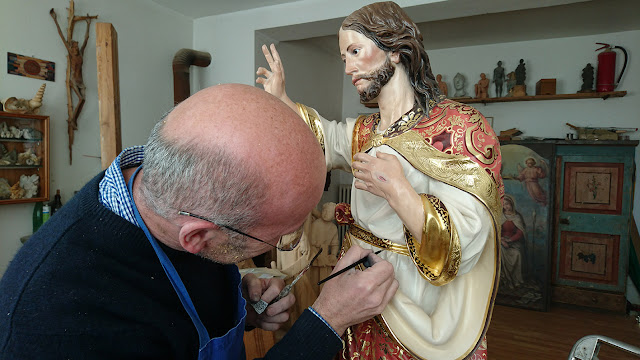The process itself is both costly and labour intensive, but the end result is more than worth the investment. It is difficult to know when and where this practice originated; certainly it is a decorative feature that we can commonly see in countries such as Portugal, Spain and Italy, but it also brings to mind the patterned stencilling and details that were so characteristic of the medieval period more generally.
Whatever the case, at Mussner G. Vincenzo's studio, the knowledge and practice of this decorative imperative is something that has been passed down from one generation to the next and certainly the transmission of the accumulated knowledge and experience from one generation of craftsman to another is an intangible factor whose importance cannot be over-estimated.
As Gregor Mussner informs us, "all of these details and decorations have to be made with great knowledge and patience.... gilded parts are always made in 22 carat gold leaf that can be applied with different techniques depending on how the client wants it to look."
If one wishes to see what a visual difference this kind of detailing can make, one need only compare this statue of Christ the King -- shown in progress above -- in its non-stencilled and stencilled incarnations (a kind of "before and after" in its own right).
One might wonder, "why bother?" when it comes to such things, but the answer to that question is first and foremost that our goal should always be to offer the most noble and beautiful liturgical art that we can -- however that might be maniest. The second consideration is of the church building itself. In churches of a more ornamental character, it can be quite easy for objects such as these to become lost in the greater church decorative scheme; ornamental details such as these can help to draw one's eye to these objects -- and it must be remembered that they serve a purpose; namely to excite the prayer and devotion of the faithful.
While we are on this subject, let's take a look at a few more of their works that include ornamental details.
 |
| St. Elizabeth of Hungary |
 |
| Detail |
 |
| S. Liberata |
 |
| Detail from a statue of Pope Leo the Great showing detailing that approximates a lace alb. |
 |
| Detail from a statue of Pope Leo the Great approximately an embroidered stole. |
 |
| Statue of St. Methodius with a stencilled chasuble that approximates a silk textile. |















